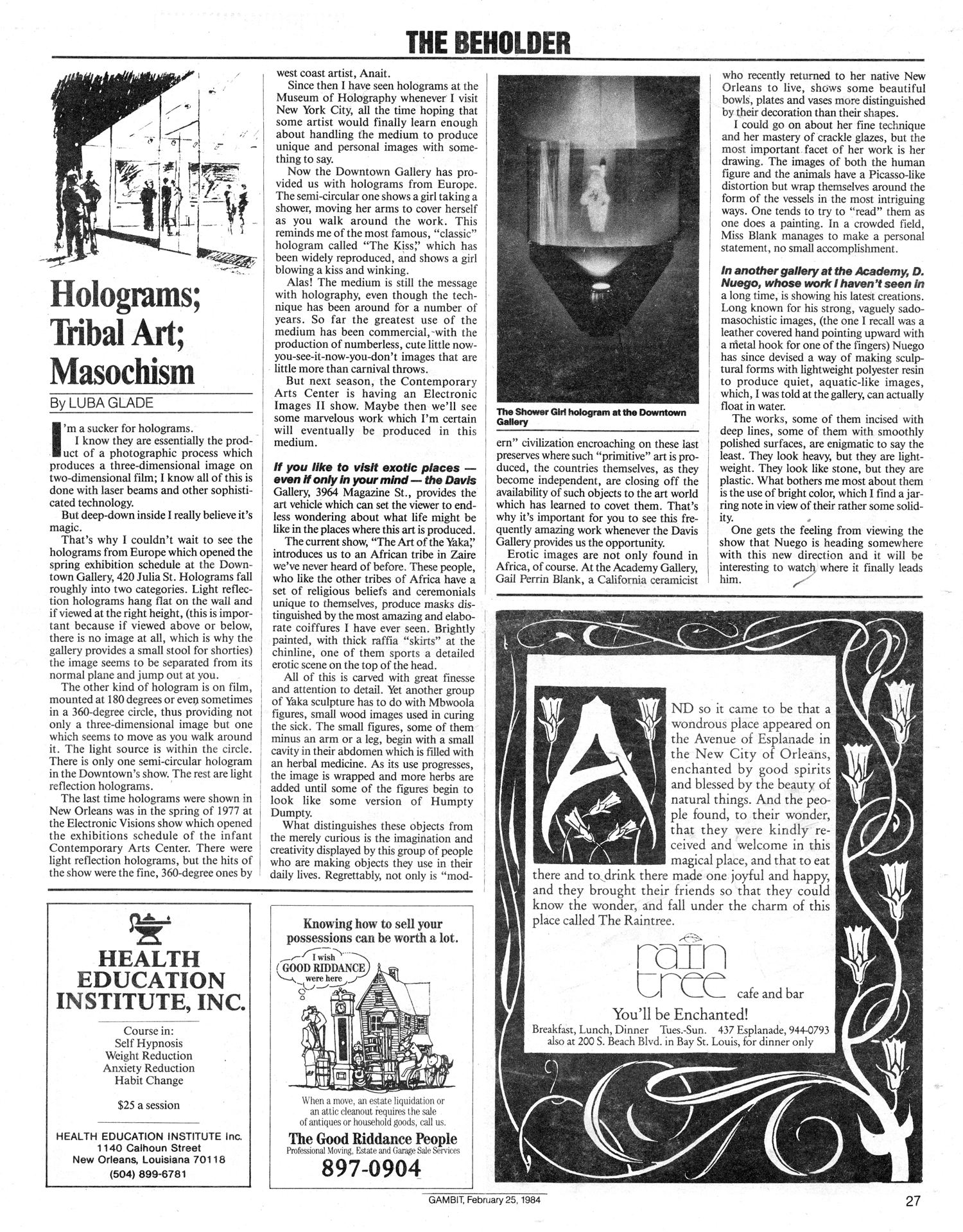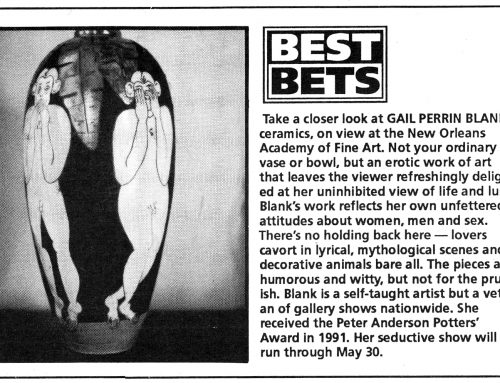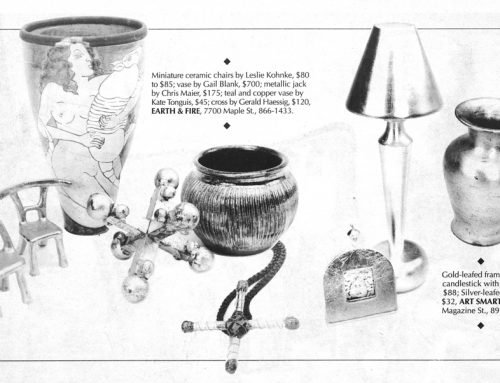Holograms; Tribal Art; Masochism
By LUBA GLADE
I’m a sucker for holograms. I know they are essentially the prod-uct of a photographic process which produces a three-dimensional image on two-dimensional film; I know all of this is done with laser beams and other sophisticated technology.
But deep-down inside I really believe it’s magic.
That’s why I couldn’t wait to see the holograms from Europe which opened the spring exhibition schedule at the Down-town Gallery, 420 Julia St. Holograms fall roughly into two categories. Light reflection holograms hang flat on the wall and if viewed at the right height, (this is impor-tant because if viewed above or below, there is no image at all, which is why the gallery provides a small stool for shorties) the image seems to be separated from its normal plane and jump out at you.
The other kind of hologram is on film, mounted at 180 degrees or even sometimes in a 360-degree circle, thus providing not only a three-dimensional image but one which seems to move as you walk around it. The light source is within the circle. There is only one semi-circular hologram in the Downtown’s show. The rest are light reflection holograms.
The last time holograms were shown in New Orleans was in the spring of 1977 at the Electronic Visions show which opened the exhibitions schedule of the infant Contemporary Arts Center. There were light reflection holograms, but the hits of the show were the fine, 360-degree ones by west coast artist, Anait.
Since then 1 have seen holograms at the Museum of Holography whenever I visit New York City, all the time hoping that some artist would finally learn enough about handling the medium to produce unique and personal images with some-thing to say.
Now the Downtown Gallery has provided us with holograms from Europe. The semi-circular one shows a girl taking a shower, moving her arms to cover herself as you walk around the work. This reminds me of the most famous, “classic” hologram called “The Kiss;’ which has been widely reproduced, and shows a girl blowing a kiss and winking.
Alas! The medium is still the message with holography, even though the technique has been around for a number of years. So far the greatest use of the medium has been commercial,-with the production of numberless, cute little now-you-see-it-now-you-don’t images that are little more than carnival throws.
But next season, the Contemporary Arts Center is having an Electronic Images II show. Maybe then we’ll see some marvelous work which I’m certain will eventually be produced in this medium.
It you like to visit exotic places —even if only In your mind — the Davis Gallery, 3964 Magazine St., provides the art vehicle which can set the viewer to end-less wondering about what life might be like in the places where this art is produced.
The current show, “The Art of the Yaka’,’ introduces us to an African tribe in Zaire we’ve never heard of before. These people, who like the other tribes of Africa have a set of religious beliefs and ceremonials unique to themselves, produce masks distinguished by the most amazing and elaborate coiffures I have ever seen. Brightly painted, with thick raffia “skirts” at the chinline, one of them sports a detailed erotic scene on the top of the head.
All of this is carved with great finesse and attention to detail. Yet another group of Yaka sculpture has to do with Mbwoola figures, small wood images used in curing the sick. The small figures, some of them minus an arm or a leg, begin with a small cavity in their abdomen which is filled with an herbal medicine. As its use progresses, the image is wrapped and more herbs are added until some of the figures begin to look like some version of Humpty Dumpty.
What distinguishes these objects from the merely curious is the imagination and creativity displayed by this group of people who are making objects they use in their daily lives. Regrettably, not only is “modem” civilization encroaching on these last preserves where such “primitive” art is produced, the countries themselves, as they become independent, are closing off the availability of such objects to the art world which has learned to covet them. That’s why it’s important for you to see this frequently amazing work whenever the Davis Gallery provides us the opportunity.
Erotic images are not only found in Africa, of course. At the Academy Gallery, Gail Perrin Blank, a California ceramicist who recently returned to her native New Orleans to live, shows some beautiful bowls, plates and vases more distinguished by their decoration than their shapes.
I could go on about her fine technique and her mastery of crackle glazes, but the most important facet of her work is her drawing. The images of both the human figure and the animals have a Picasso-like distortion but wrap themselves around the form of the vessels in the most intriguing ways. One tends to try to “read” them as one does a painting. In a crowded field, Miss Blank manages to make a personal statement, no small accomplishment.
In another gallery at the Academy, D. Nuego, whose work I haven’t seen In a long time, is showing his latest creations. Long known for his strong, vaguely sado-masochistic images, (the one I recall was a leather covered hand pointing upward with a Metal hook for one of the fingers) Nuego has since devised a way of making sculptural forms with lightweight polyester resin to produce quiet, aquatic-like images, which, I was told at the gallery, can actually float in water.
The works, some of them incised with deep lines, some of them with smoothly polished surfaces, are enigmatic to say the least. They look heavy, but they are light-weight. They look like stone, but they are plastic. What bothers me most about them is the use of bright color, which I find a jar-ring note in view of their rather some solidity.
One gets the feeling from viewing the show that Nuego is heading somewhere with this new direction and it will be interesting to wit, where it finally leads him.






